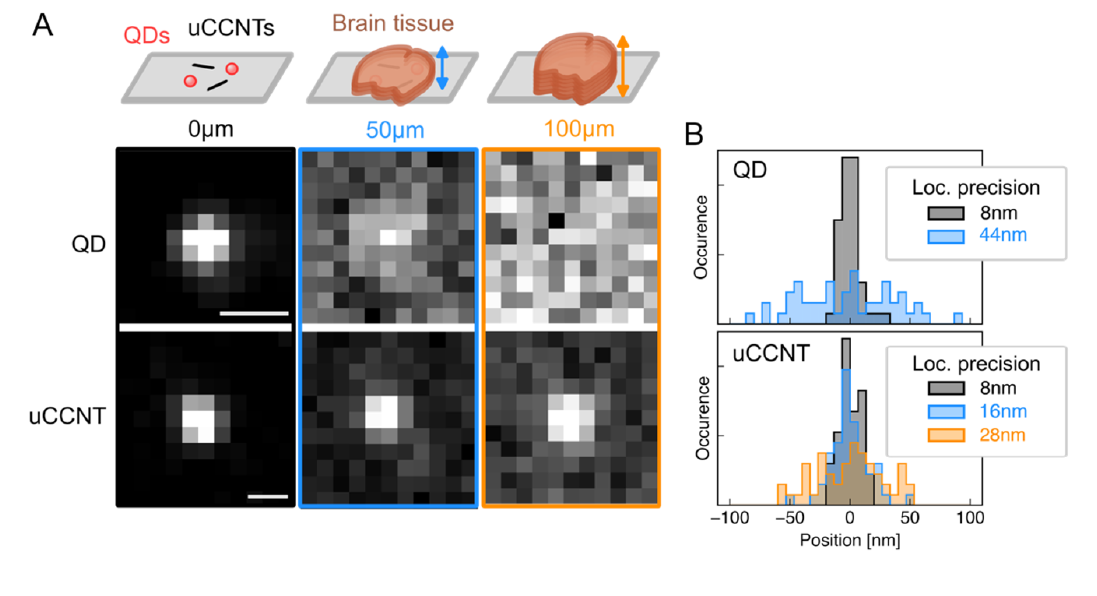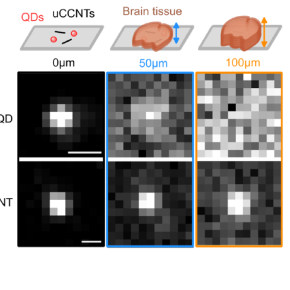Ultrashort and Ultra-bright Nanotubes for Deep Tissue Exploration
By introducing luminescent defects in a controlled manner into carbon nanotubes just a few tens of nanometers long, researchers have managed to maintain intense infrared emission. This breakthrough paves the way for a new generation of probes for deep tissue imaging.
References :
Ultrashort Carbon Nanotubes with Luminescent Color Centers Are Bright NIR-II Nanoemitters, Somen Nandi, Quentin Gresil, Benjamin P. Lambert Finn L. Sebastian, Simon Settele, Ivo Calaresu, Juan Estaun-Panzano, Anna Lovisotto, Claire Mazzocco, Benjamin S. Flavel, Erwan Bezard, Laurent Groc, Jana Zaumseil, Laurent Cognet, ACS Nano 2025 19 (21), 19818-19830 - Published on 16 May 2025.
DOI: 10.1021/acsnano.5c02171
Achieving highly luminous nano-emitters in the near-infrared is a major challenge for various applications, ranging from biological imaging to quantum optics. Researchers from three CNRS laboratories, in collaboration with the University of Heidelberg and Karlsruhe Institute of Technology, have just made a significant step forward by creating ultrashort carbon nanotubes with luminescent color centers that maintain surprisingly intense photoluminescence in the infrared window between 1000 and 1350 nm (the NIR-II window), where biological tissues are most transparent. Their work was published in ACS Nano.
The present research was conducted in the following CNRS laboratories:
- Laboratoire Photonique Numérique&Nanosciences (LP2N, CNRS/Institut d'Optique Graduate School/Université de Bordeaux)
- Institut Interdisciplinaire de Neurosciences (IINS, CNRS/Université de Bordeaux)
- Institut des Maladies Neurodégénératives (IMN, CNRS/Université de Bordeaux)
In their longer form, some carbon nanotubes are already used as infrared emitters due to their stability and luminescence efficiency. However, when their length is reduced below 100 nm, the photoluminescence decreases drastically. The team overcame this challenge by introducing controlled defects on the nanotube walls, which concentrate the light emission at specific sites and prevent premature extinction.
They successfully produced nanotubes as short as 50 nanometers, which turned out to be surprisingly bright. Their brightness surpasses that of many visible nano-emitters, such as quantum dots (QDs), while offering better stability and natural compatibility with biological environments. For the first time, objects of this size achieved the expected brightness for ideal nanotubes, an observation never made before.
The researchers demonstrated the utility of these nanotubes by injecting them into mouse brain slices. Their brightness allowed for precise, 3D tracking of individual particle movement up to 100 μm deep—far surpassing the tracking capabilities of quantum dots (see illustration).

The nanotubes remain clearly detectable and locatable with nanometric precision up to a depth of 100 µm.© S. Nandi et al.
These results open the door to a new generation of infrared probes for high-resolution biological imaging, especially in thick tissues where few emitters remain detectable. But their impact goes far beyond this field: these ultrashort nanotubes could also play a key role in the development of quantum photonic sources or serve as ultra-bright emitters for telecom wavelengths, which are highly sought after in quantum information technologies.
